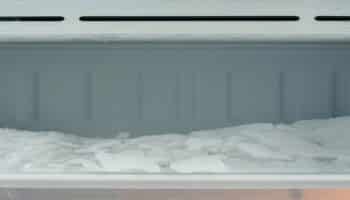Are you trying to figure out if you can leave a freezer outside?
Believe it or not, that’s a widespread question! While your first thought when buying a freezer might not be to put it out in the open, sometimes it’s necessary for various purposes, such as freeing up space in your basement or kitchen.
Freezers look sturdy, and at first glance, you might be tempted to think that you can, in fact, place them in your backyard without consequences. Whether this is true will be covered further down, but even if it is possible, there are some things that must be taken into account.
Below, I’ve prepared a small piece including everything you need to know when looking into moving this appliance outside, as well as critical dos and don’ts.
When thinking of leaving your freezer outside, it’s critical that you consider the effects that corrosion, extreme heat, and wildlife can have on it. Also, while it might be counterintuitive, it’s important to take into account the negative impact that freezing temperatures can have on the appliance.
Read on to make an informed decision!
#1 Corrosion Is the Enemy
Let’s start off by talking about the first big issue of leaving your freezer outside. This might or might not be something to watch out for depending on where you live. Corrosion happens to all things when left out in the open for a very long time, but it takes hold at an accelerated rate near the sea.
As you know, seawater is not drinkable due to the amount of salt it contains. However, even if you don’t consume it, it can still affect the exterior of your home, car, and appliances. The salty environment around coastal areas is known for harboring the perfect conditions for corrosion acceleration.

Leaving your freezer outside under climate conditions such as these can quickly cause its exterior to start showing signs of damage.
Who knew that living near the sea could have a downside, huh?
Solution: As you might have guessed, the best way to prevent your freezer from corroding in coastal environments is to keep it indoors. However, if this is simply not possible, you might want to try covering it with breathable fabric.
This is not something I 100% recommend, as you’ll be protecting the unit from external weather conditions, but also taking away the critical breathing room it needs to ensure maximum operating efficiency. Your freezer will not be able to dissipate heat as effectively if it has anything over it, so you might want to weigh your options.
At the end of the day, it will come down to what matters most to you – saving money in utilities every month, or protecting your appliance from corrosion.
#2 Beware of Extreme Heat
Assuming you don’t live anywhere near a beach, you’re sadly still not in the clear. You might have already guessed that heat isn’t great for an appliance designed to keep groceries under freezing temperatures. But the reasoning behind this is more complex than you think.
Make no mistake, in most cases, even on sweltering days, your freezer will keep your food frozen and safe if it stays plugged in and works normally. However, these results will take many more resources than they should.
You see, in order to stay in subzero temperatures, your unit uses a series of coils, a compressor, and a liquid called refrigerant that is constantly being changed to gas and back into a liquid. The cooling process dissipates heat while preserving whatever you place inside the appliance’s compartment.
However, if you leave your freezer outside, and live in a place where high temperatures and humidity levels are common, you could be forcing the appliance to overtax itself trying to keep its internal temperature steady. This directly results in higher-than-normal electricity bills every month and also poses the risk of spoiling your food if your freezer can’t keep up with the heat.
Solution: The best way to prevent heat from causing your problems is by placing your appliance in the shade. By keeping it out of direct sunlight, the temperature around and inside the unit will be much lower than if you just leave it anywhere in your backyard.
Note: The sun moves around during the day, and so does the shade. If you want to guarantee that your appliance will always be away from direct sunlight, take this into account. Sometimes, something as simple as building a small “roof” for your freezer can work wonders.
#3 Watch Out for Wildlife
This one might not be on many people’s list of priorities, but it has been known to be an issue for some freezer owners who have tried this.
If you’ve been on the internet for a while, you’re probably no stranger to those hilarious videos of raccoons and bears digging through people’s trashcans in search of food. But what if I told you that the same thing can happen if you leave your freezer outside?

Placing your appliance out in the open will leave it (and anything inside it) prone to being at the mercy of unwanted neighbors. Although freezers are normally hermetic, certain food aromas can escape into the air when you open or close the door to take groceries out or place them inside the compartment.
This is more than enough to attract the attention of wildlife that might be in desperate need of nourishment.
Solution: To keep your food safe, I recommend buying a strong padlock that you can place on the freezer’s door. Granted, this won’t prevent animals from wandering into your home’s surroundings, nor shield the unit from scratching and other damage, but at least you’ll know a wild raccoon won’t feast on your A5 marbling score Wagyu!
#4 Avoid External Freezing Temperatures
I know what you’re thinking, “how can freezing temperatures affect something that’s supposed to freeze things?!”, and I understand your thought process. However, to explain why it can be bad to place your appliance out in the cold, it’s crucial to look at its internal components.
As I mentioned earlier, in order to dissipate heat and freeze your food, your unit uses a series of coils, refrigerant liquid, and a compressor. The latter works with the help of special oil that keeps it lubricated, and in tip-top shape. However, this substance is sensitive to temperature, and it can freeze somewhat easily.
This can not only make it impossible for your appliance to keep itself cold, but also decrease its lifespan significantly, and even trip your breakers when you plug it in.

Now, you’re probably wondering why this is an issue while outdoors, but not indoors, and the answer is simple – the compressor is not exposed to subzero temperatures normally.
Since it’s normally located at the back of the unit and separate from its compartment, it’s never really in direct contact with the cold keeping your food frozen. When leaving your freezer outside, this still holds true; however, the compressor will be exposed to the weather and the low temperatures that might come with it.
Solution: If you live in an area with harsh winters and want to leave your appliance outside, you’re not out of luck, you just need to do things right. Depending on how cold it is outside, you might not need to plug your freezer into the wall outlet, as the weather alone might be able to keep your food fresh and frozen.
Having the compressor oil freeze is only an issue if you’re actually running the appliance, so if you’re not, you don’t really have to worry about this. Just make sure that you place the freezer somewhere a little warmer to let the oil thaw out before you plug it back into the wall.
Note: Taking advantage of the weather can help you save hundreds of dollars in utilities every year.
Best Practices
Now that we’ve covered everything that can go wrong with leaving your freezer outside, let’s talk about some habits that I’m sure you’ll find beneficial.
Check the Door Seals Often
Leaving your freezer outside puts whatever’s inside it at a greater risk of going bad, especially in hot weather. If your unit’s door seals are damaged or placed improperly, the appliance will have a harder time maintaining steady temperatures, drawing excessive amounts of power for no good reason.
The good news is that, even in the event that you do notice that your appliance’s door seal has any kind of damage to it, replacing it is very easy. Removing the rubber strip shouldn’t take more than a minute, and the same goes for placing the new one on.
Moreover, online marketplaces sell them for as little as $30, so you won’t have to break the bank to ensure proper insulation on your appliance.
Don’t Overfill the Compartment
This is advised against for several reasons, but mostly, it’s because your appliance is designed to freeze and maintain low temperatures for a certain amount of food. Overfilling the compartment can make the unit have to work harder to reach the desired temperature, and if it fails, it could cause your food to go bad.
This can even happen indoors, so you can imagine how much worse the situation can get if you leave your freezer outside. Placing your appliance outdoors and overfilling it can accelerate the rate at which your food thaws, and before you know it, you could be stuck with a whole container full of rotten groceries.
Not to mention that you’ll be paying much more than you normally would for electricity, and with no added benefits.
Defrost Before Using
This one you’ve probably heard before, but it becomes even more critical when thinking of leaving your freezer outside. As I mentioned earlier, you can do this somewhat safely in the winter as long as you unplug the appliance from its power supply. The cold weather should act as a natural refrigerant, keeping your food fresh and frozen.
However, regular defrosting is a must if you’re planning on doing this, as excess ice can damage the appliance’s components that are not meant to be in contact with freezing temperatures for long.
Ideally, you’ll want to leave the unit defrosting for a couple of hours once every two-three months. You can do this by bringing it inside your home and waiting until all the excess ice has melted off.
If you’re ever planning on bringing the freezer back inside and plugging it back in, it’s critical that you let it defrost completely before supplying it with power, as the compressor oil needs to be fully thawed out.
Place the Unit in the Garage
Lastly, let’s go over a reasonable alternative to keep your freezer “outside” without actually exposing it to all the potential threats mentioned above. If you have enough space and the suggestion works for you, you can always place the unit in the garage.
This way, you can keep it plugged in during the winter, and it will be protected against direct sunlight and curious paws.
Conclusion
That about sums it up.
When thinking about leaving your freezer outside, there will always be measures that you must take and many more things to consider.
I hope this piece has helped you better understand the most common dos and don’ts of outdoor freezer placement so that you can try it with confidence if you so choose. In most cases, getting a padlock for your appliance and watching out for extreme weather will be more than enough to keep things running smoothly.
Thank you very much for sticking with me all the way to the end. If this article piqued your interest and answered your most burning questions, you’ll be happy to know that there are many more resources you can learn from below.
On the site, you’ll find all kinds of solutions for daily appliance issues, such as an ice maker that keeps freezing over, or an oven that’s leaking grease.
Have a wonderful week!
— Craig.






